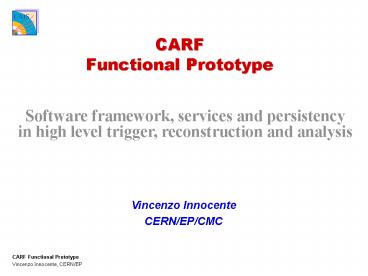CARF Functional Prototype - PowerPoint PPT Presentation
Title:
CARF Functional Prototype
Description:
anti-select events based on reconstruction information ... All these technologies have proven to work well and fulfill the requirements for ... – PowerPoint PPT presentation
Number of Views:34
Avg rating:3.0/5.0
Title: CARF Functional Prototype
1
CARFFunctional Prototype
Software framework, services and persistency in
high level trigger, reconstruction and analysis
- Vincenzo Innocente
- CERN/EP/CMC
2
CMS Experiment-Data Analysis
Quasi-online Reconstruction
Environmental data
Detector Control
Online Monitoring
store
Request part of event
Store rec-Obj
Request part of event
Event Filter Object Formatter
Request part of event
store
Persistent Object Store Manager
Object Database Management System
Store rec-Obj and calibrations
store
Request part of event
Data Quality Calibrations Group Analysis
Simulation G3or G4
User Analysis on demand
3
CARFCMS Analysis Reconstruction Framework
Physics modules
Specific Framework
Reconstruction Algorithms
Data Monitoring
Event Filter
Physics Analysis
Generic Application Framework
Calibration Objects
Event Objects
Configuration Objects
CMS adapters and extensions
Utility Toolkit
ODBMS
C standard library Extension toolkit
Geant3/4
CLHEP
Paw Replacement
4
CMS Software RD
- 95-96 RD41 --- OO Detector Reconstruction
- Detector model, Local hit cache, Pattern
recognition - 95-97 RD45 --- OO Event Model (persistent)
- Event structure, Raw data, Reconstructed objects
- 95-97 RD45 --- Calibration Database
- Time dependent data, Versioning, Experience with
Objectivity/DB - 96-98 Program Architecture
- Implicit invocation, Event dispatching,
Reconstruction on demand - 97-98 Test-Beam (H2, X5)
- OO DAQ, Online filtering, ODB population,
Interactive analysis - 99-00 Test-Beam ORCA Production
- Event-Collections, Concurrent jobs,
Multi-threading, RT dynamic loading - Production management, MSS interface, Data
import-export - User databases, User event-collections
- Event visualization, Interactive analysis
5
CARF Components
- Basic Utility ToolKit
- Once was CERNLIB
- Today a set of classes that extends the standard
C and C libraries - Basic Mechanisms
- Sets of collaborating classes, implementation of
the most popular patterns - Base of Object Oriented Programming
- Basic Persistency Support
- Objectivity Wrappers
- Generic Persistent Classes
- User Interface
- Links keywords to objects
- Inputs from ascii file, database objects,
interactive shell
6
CARF Components
- Persistent Object Model
- Event Catalog, Configuration and MetaData
- Simulated Event
- RawEvent (SimHits and Digis)
- Reconstructed Objects
7
CARF Components
- Framework
- Package Initializer
- Event Reader
- Configuration management
- DataBase Populator
- API (for developers)
- Simulated-Event Source
- SimHit Formatter
- SimHit Loader
- Reconstruction Detector
- Reconstruction Unit
- API (for users)
- Selectors
- Event Observers (Analyzers, Filters, etc)
- RecObj Collection
8
Functionalities
- Basic Application
- Iterates over an input Event Collection
- Selects events based on MetaData
- Today based just on event- and run-number and
data availability - Tomorrow will use user-defined Annotations
- Dispatch Events to Observers
- Standard and/or user module to
- Analyze and classify the event
- produce or update reconstructed event objects
- anti-select events based on reconstruction
information - Force production of persistent objects if
required - Produce an output Event Collection
- Any combination of shallow and deep copy of any
part of the event is in principle allowed - In practice few predefined options
9
Functionalities
- Simulation Application
- Back-end to Detector Simulation to provide
persistency support for simulated tracks and hits - Standard CMSIM converts from FZ to CARF/ORCA
- new G4 prototype converts from G4 to CARF/ORCA
10
Functionalities
- SimReader Application
- Reads output of Simulation and perform
digitization - Reads pile-up pseudo-randomly from a large event
collection - Can perform reconstruction if required
- Force digitization for all registered detectors
11
Functionalities
- Reconstruction Application
- Read Output of a previous Digitization or
Reconstruction - will re-digitize and re-reconstruct any detector
declared obsolete - will digitize and reconstruct any newly
registered detector and reconstruction-unit
12
Quality
- Performance
- Framework performance not yet critical
- Some problems in opportunistic MetaData update
from several concurrent jobs - Reliability
- All components (CARF, Objy servers) seem to be
reliable for single-user applications (some
problems from HPSS) - Still some problems in massive production (above
150 concurrent jobs) - Code quality still at prototype level
- Major coding guide-lines were not correctly
identified or overlooked - too much use of inline code
- too many compilation- and run-time dependencies
- user API too complex
- Requirements and priorities should be redefined
13
Impact of Strategic choices
- CMS has choose a non-traditional approach in
several strategic areas - Object-Oriented Programming in C
- Object Database Management System
- Plug-in
- Implicit invocation
- Multi-thread
- Opportunistic Database access
- All these technologies have proven to work well
and fulfill the requirements for the framework
and in several prototype - We should now evaluate their impact on non-core
software and on users code.
14
Short Term Plan
- Basic ToolKit
- Integrate with IGUANA, FAMOS and OSCAR equivalent
- Integrate with ANAPHE?
- Basic Persistency
- Extend to other projects
- integrate with HEPODBMS?
- Persistent Data Model
- Extend to other projects
- Prototype realistic RecObjs
- Investigate Generic User-data such as
- Annotations
- tuples
- Answer to the question
- What new kind of objects should be stored
during physics analysis?
15
Outlook
- Most of the functionalities identified in the CTP
and in later more detailed requests (HLT for
instance) have been implemented - Performance and Reliability not yet at production
level - Code quality still at prototype level
- Requirements and priorities should be redefined
in this area - Non-traditional technologies seem working well
for core-software - Impact on non-core software should be evaluated.































